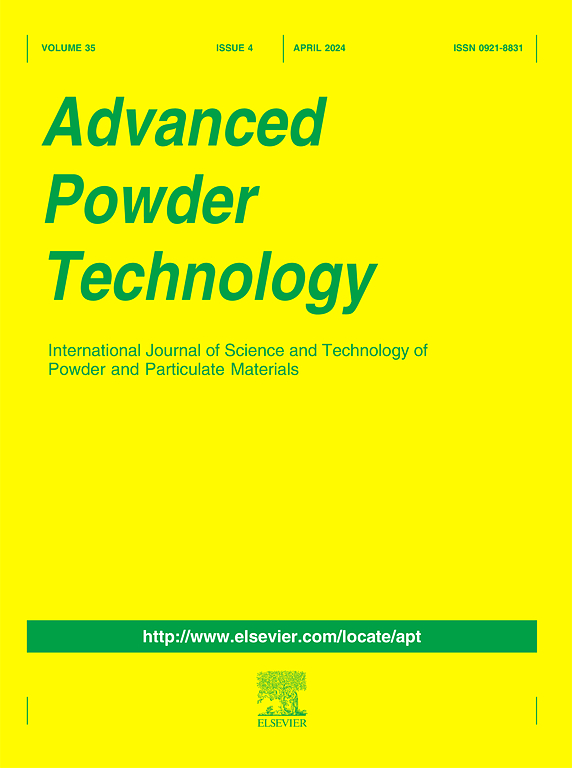C壳厚度可调的FeCo-C核壳纳米粒子的微波吸收及其机理
IF 4.2
2区 工程技术
Q2 ENGINEERING, CHEMICAL
引用次数: 0
摘要
为了解决C壳厚度如何影响金属-C核壳纳米粒子的微波吸收特性这一关键问题,通过在空气中简单退火合成了具有相同金属核但不同碳壳厚度的FeCo-C核壳纳米粒子。研究采用了自由电子极化理论,并由此引入了损耗图的极化存储依赖性,即 "εp′-εp",以阐明微波吸收的基本机制。研究发现,随着碳壳变薄,介电常数、传导损耗和极化损耗都会降低。同时,C 壳的厚度可以很好地调节纳米粒子的磁共振频率和强度。值得注意的是,C 壳越厚,极化弛豫过程越完整,极化损耗也越大。由于具有最佳的介电和磁性能,FeCo-C 纳米粒子在 3.5 mm 时的最佳反射损耗值高达 -72.2 dB,有效吸收带宽为 7.6 GHz。这些结果表明,合成的 FeCo-C 核壳纳米粒子是微波吸收应用的理想候选材料。此外,"εp′-εp "图的引入有望对微波吸收领域产生重大影响。本文章由计算机程序翻译,如有差异,请以英文原文为准。

Microwave absorption of FeCo-C core–shell nanoparticles with tunable thickness of C shells and the underlying mechanism
In order to address the key question of how the thickness of the C shell affects the microwave absorption properties of metal-C core–shell nanoparticles, FeCo-C core–shell nanoparticles, with identical metal cores but varied carbon shell thicknesses, were synthesized by simply annealing FeCo-C core–shell nanoparticles in air. The free electronic-polarization theory was employed, and thus the polarization storage dependence of the loss plot, i.e., was introduced to elucidate the underlying microwave absorption mechanism. It was found that permittivities, conduction and polarization losses degrade as the carbon shell becomes thinner. Meanwhile, the thickness of the C shells was well adjusted to tune the magnetic resonance frequencies and intensities of the nanoparticles. Notably, a thicker C shell enhances the complete polarization relaxation process and increases polarization loss. Due to optimal dielectric and magnetic properties, FeCo-C nanoparticles exhibit an optimal reflection loss value up to −72.2 dB and an effective absorption bandwidth of 7.6 GHz at 3.5 mm. These results indicate that the synthesized FeCo-C core–shell nanoparticle is a promising candidate for microwave absorption applications. Furthermore, the introduction of plot is expected to have a significant impact on the field of microwave absorption.
求助全文
通过发布文献求助,成功后即可免费获取论文全文。
去求助
来源期刊

Advanced Powder Technology
工程技术-工程:化工
CiteScore
9.50
自引率
7.70%
发文量
424
审稿时长
55 days
期刊介绍:
The aim of Advanced Powder Technology is to meet the demand for an international journal that integrates all aspects of science and technology research on powder and particulate materials. The journal fulfills this purpose by publishing original research papers, rapid communications, reviews, and translated articles by prominent researchers worldwide.
The editorial work of Advanced Powder Technology, which was founded as the International Journal of the Society of Powder Technology, Japan, is now shared by distinguished board members, who operate in a unique framework designed to respond to the increasing global demand for articles on not only powder and particles, but also on various materials produced from them.
Advanced Powder Technology covers various areas, but a discussion of powder and particles is required in articles. Topics include: Production of powder and particulate materials in gases and liquids(nanoparticles, fine ceramics, pharmaceuticals, novel functional materials, etc.); Aerosol and colloidal processing; Powder and particle characterization; Dynamics and phenomena; Calculation and simulation (CFD, DEM, Monte Carlo method, population balance, etc.); Measurement and control of powder processes; Particle modification; Comminution; Powder handling and operations (storage, transport, granulation, separation, fluidization, etc.)
 求助内容:
求助内容: 应助结果提醒方式:
应助结果提醒方式:


